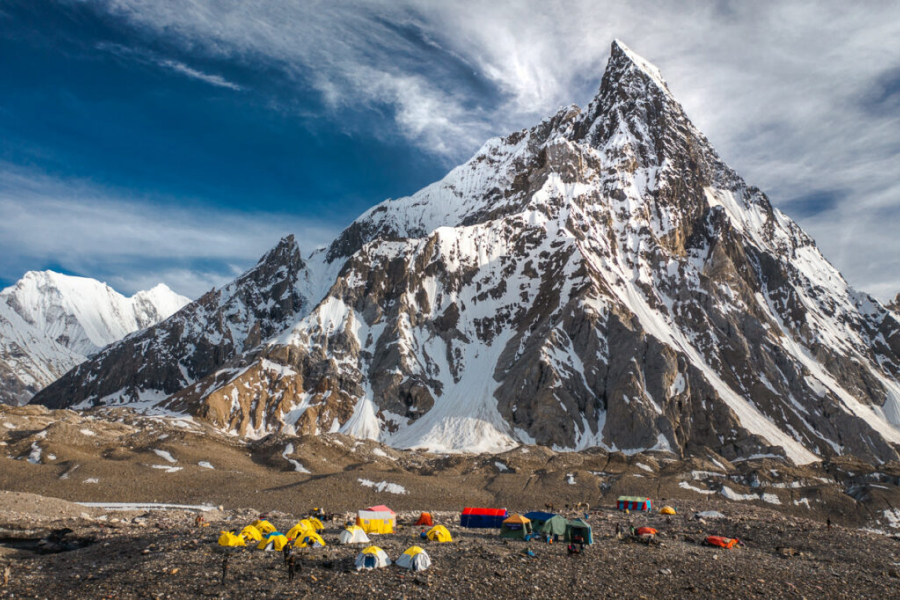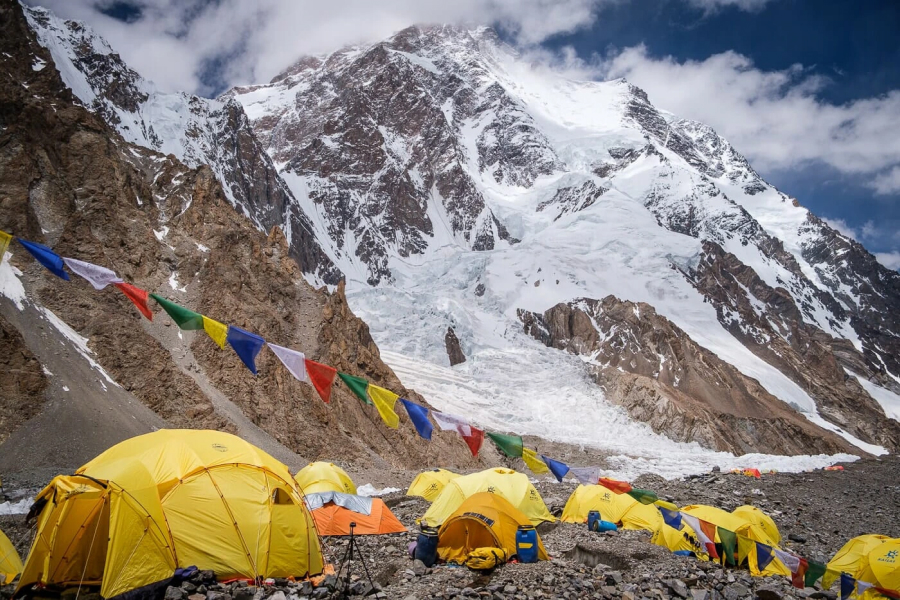The K2 Base Camp trek is a daring adventure that promises breathtaking views, challenging terrains, and an experience of a lifetime. However, one critical factor that every trekker must grapple with is the ever-changing weather conditions.
FAQS:
Where is the K2 Base Camp Trek?
The trek begins in the town of Skardu, the gateway to the Karakoram region. From Skardu, trekkers embark on a mesmerizing journey through glaciers, including the Baltoro and Godwin Austin glaciers, before reaching the illustrious K2 Base Camp. Situated in the Gilgit-Baltistan region of Pakistan, the trek covers approximately 62 miles (100 kilometers). It typically takes 11-13 days for a round trip from Askole.
How Hard is the K2 Base Camp Trek?
This trek is renowned for its challenging nature, demanding moderate physical fitness and endurance. Factors contributing to its difficulty include high altitudes, unpredictable weather, rough terrain, and the length of the trek. Trekkers are advised to have prior experience with high-altitude trekking and be in good physical condition.

Overview of K2 Base Camp Trek Weather:
The weather at K2 Base Camp is as dynamic as the landscape itself. Situated in the Karakoram Range of the Himalayas, this trek takes you through various weather conditions, from freezing temperatures in winter to mild summers. The temperature variations are significant, and trekkers must be prepared for sudden weather changes.
Seasonal Variations:
Understanding the four distinct seasons in the region is crucial for planning a successful trek. December through February brings cold and dry conditions, while March to May sees the onset of a hot and dry spring. The summer and rainy seasons prevail from June to September, with the monsoon period in October and November. Each season presents challenges and wonders, making the trek a unique experience throughout the year.
Detailed Weather Analysis by Month:
Breaking down the weather by month provides a more nuanced understanding for trekkers. In January, average daily lows hover around 2 degrees Celsius, making it a frigid start to the year. June sees a dramatic shift, with average daily highs reaching 40 degrees Celsius. The summer months, especially July and August, bring about half the annual rainfall, averaging around 245 millimeters each month.
Microclimates at Concordia and K2 Base Camp:
The area around Concordia and K2 Base Camp exhibits its own microclimates. Trekkers often encounter cloud formations and snowfall during June and early July. With its unique geography, Concordia can have clear skies in August, defying the monsoon season norms. This microclimate adds an element of unpredictability to the trek, keeping adventurers on their toes. Read more about the K2 Expedition.
Navigating Altitude and Weather Challenges:
Welcome back to the second installment of our exploration into the fascinating world of K2 Base Camp trek weather and seasonality. In this segment, we will delve into the impact of altitude on weather, address frequently asked questions, and highlight safety measures crucial for trekkers venturing into this high-altitude realm. Read more about the K2 Mountain – Facts and Information.

Impact of Altitude on Weather:
The K2 Base Camp trek isn’t just a test of physical endurance; it’s also a battle with the elements at high altitudes. As trekkers ascend, the temperature variations become more pronounced. Altitude can cause a drop in temperatures, and at heights above 4100 meters, it’s not uncommon for the mercury to plummet below freezing, reaching as low as minus 10°C. Understanding how altitude influences weather is paramount for a safe and enjoyable trek.
Weather-Related FAQs:
Many trekkers embark on the K2 Base Camp journey with burning questions about the weather. Is there a monsoon season impact in Concordia? Why do clouds linger in June, and what about the clear skies in August? These questions reflect the intricate dance between geography and weather patterns unique to the Karakoram Range. We’ll unravel these mysteries to ensure you’re well-prepared for the unexpected twists and turns of the trek.
Historical Weather Patterns:
Analyzing historical weather data for the K2 Base Camp region provides valuable insights into trends and fluctuations. Trekking conditions can vary yearly, and understanding these patterns helps trekkers make informed decisions about when to embark on this challenging journey. We’ll explore the historical weather patterns and discuss how climate change may impact the region.
Weather and Landscape Interaction:
The interaction between weather and the landscape is a captivating aspect of the K2 Base Camp trek. From glacier movements to the shaping of the terrain, weather plays a pivotal role in crafting the breathtaking scenery trekkers encounter. Understanding these dynamics enhances the appreciation for the natural forces at play during this high-altitude adventure.
Planning Your Journey Amidst Nature’s Fury:
Welcome to the final installment of our exploration into the enigmatic world of K2 Base Camp trek weather and seasonality. In this segment, we’ll equip you with practical tips for planning your trek based on weather conditions, delve into safety considerations, and explore why now might be the opportune moment to embark on this epic adventure.
Planning Your Trek Based on Weather:
Timing is everything when it comes to the K2 Base Camp trek. The best time to undertake this challenging journey is during July and August. These months offer the most favorable weather conditions, with clear skies and manageable temperatures. Planning your itinerary around these months ensures a safer and more enjoyable experience, minimizing the risks associated with extreme weather.

K2 Base Camp Trek Safety Tips:
Embarking on the K2 Base Camp trek involves certain risks and challenges, especially when it comes to weather-related factors. To ensure a safe journey, trekkers must adhere to specific safety tips. Acclimatization is crucial at high altitudes, and recognizing the symptoms of altitude sickness is paramount. Additionally, trekkers should be well-prepared for unpredictable weather changes, carry essential gear, and be aware of emergency procedures.
Why Now? The Current Landscape of K2 Base Camp Trek Tourism:
In recent years, the Karakoram region’s tourism landscape has seen a shift. Relaxing visa restrictions, introducing an e-visa system, and increasing accessibility through international flights have made Pakistan a more inviting destination. With the global spotlight on Pakistan’s natural beauty and the British Royal Family’s visit in 2019, the allure of the K2 Base Camp trek has grown.
The COVID-19 pandemic has temporarily halted tourism, creating opportunities for those seeking a less crowded and more serene experience. Pakistan is eager to welcome new visitors as the world emerges from lockdowns. Travel experts predict Pakistan as the “next big thing” in the travel industry, making this the perfect moment to plan your K2 Base Camp trek.
Discover The Epic K2 Base Camp Trek:
Welcome to continuing our exploration into the intricacies of the K2 Base Camp trek. In this final installment, we’ll delve into the terrain camping essentials and provide additional insights to ensure your journey is memorable and seamless.
Terrain: The Challenging Path to K2 Base Camp:
The trek through the Karakoram region is not for the faint of heart. The terrain is rugged, with loose stones on glaciers and uneven paths. Trekkers should be prepared for steep ascents and descents, river crossings, and ever-shifting ice. Navigating this challenging terrain requires careful planning and proper equipment, emphasizing the need for physical fitness. Read more about the K2 Base Camp Trek | Pakistan’s No.1 K2 Guide.
Porters and Camping Equipment:
To ease the physical demands of the trek, most trekkers opt to hire local porters who carry their belongings. These porters are invaluable, not only for lightening the load but also for their knowledge of the terrain. Additionally, outfitters typically provide camping equipment, including kitchen tents, sleeping tents, mess tents, chairs, and dining tables. Choosing the right package that suits your comfort level is essential for a smoother trekking experience.
Camping: Immersed in Nature’s Grandeur:
Camping is the only accommodation option during the K2 Base Camp trek, with tents typically designed for two persons. Solo trekkers may share tents or opt for a single supplement. The campsites, some situated on glacier surfaces, demand proper preparation. Using a thick, warm mattress under the sleeping bag is essential, especially in locations where the terrain is unforgiving. Trekkers are also advised to follow the “leave no trace” principle, particularly in areas without toilet facilities.
Conclusion: Conquering K2 Base Camp – A Triumph of Nature and Human Spirit
In concluding our exploration of the K2 Base Camp trek, we celebrate the triumphant fusion of nature’s grandeur and the indomitable spirit of those who dare to venture into its heart. The journey through the Karakoram Range, with its ever-changing weather, challenging terrain, and awe-inspiring landscapes, is a testament to the resilience of the human spirit.
The Soul-Stirring Views:
Reaching K2 Base Camp is not just a physical accomplishment; it’s an emotional and spiritual journey. Standing amidst the towering peaks of the Karakoram, including Broad Peak, Gasherbrum I and II, and the mighty K2, trekkers are rewarded with views that defy description. The soul-stirring beauty of these snow-clad giants is a memory etched in the hearts of those fortunate enough to experience it.
Preserving the Pristine Wilderness:
As you embark on this trek, remember the importance of responsible trekking. The pristine wilderness of the Karakoram deserves our utmost respect. Follow the principles of Leave No Trace, minimize your environmental impact, and contribute to preserving this remarkable natural haven for future generations.
The Perfect Time is Now:
In the current landscape of travel, with relaxed visa restrictions, improved accessibility, and the post-pandemic resurgence of tourism, now is the perfect time to plan your K2 Base Camp trek. Experience the allure of this less-crowded destination, where tranquility meets adventure, and every step is a brush with the raw beauty of nature.
Embarking on Your Journey:
As you prepare to embark on this epic adventure, equipped with knowledge about the weather, terrain, and safety measures, remember that the K2 Base Camp trek is not just about reaching a destination. It’s about embracing the journey, conquering challenges, and discovering the depths of your strength.
May your trek be blessed with clear skies, camaraderie with fellow adventurers, and moments of profound connection with the untamed wilderness. Whether you undertake the journey for the physical challenge, the breathtaking vistas, or the sheer thrill of adventure, the K2 Base Camp trek is a voyage that transcends the ordinary.
In the spirit of exploration and the pursuit of the extraordinary, we wish you a transformative and unforgettable K2 Base Camp trek. As you step into the shadows of the mighty K2, may the mountains echo the triumph of your spirit. Read more about the K2 Expedition | Pakistan’s No.1 Guides.

